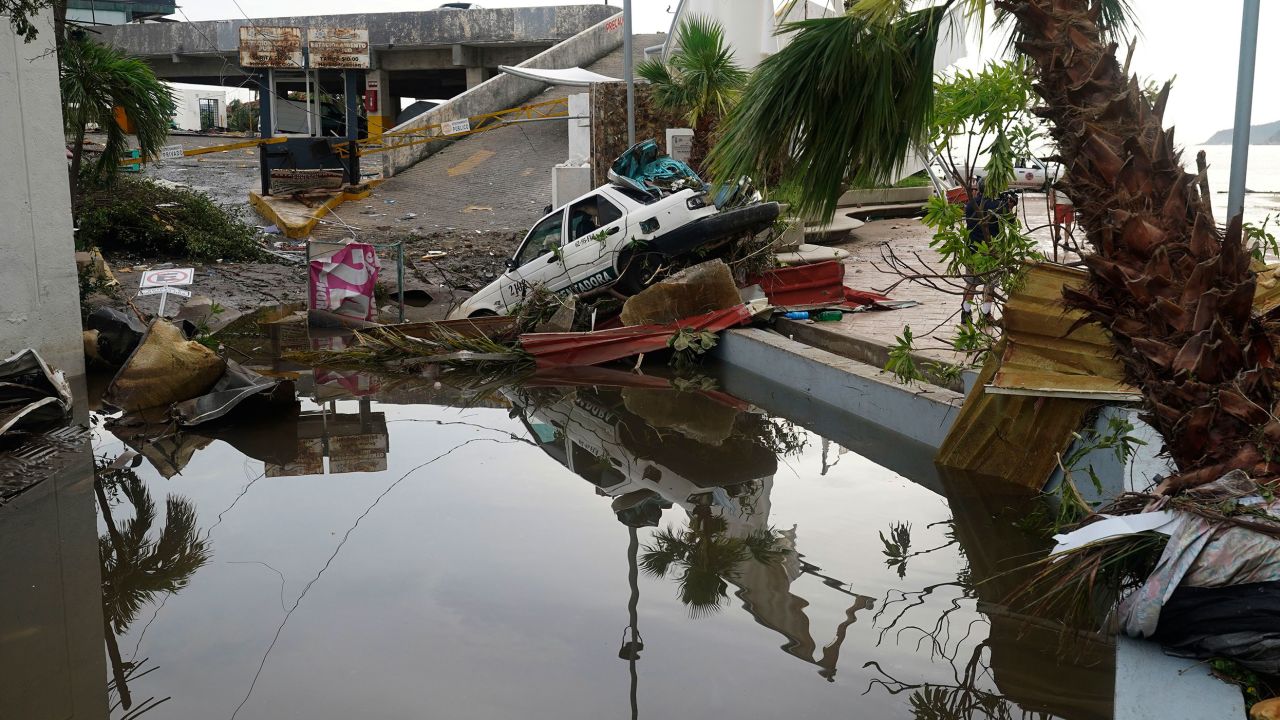Science
Otis’ Stunning Turn To Monster Pacific Hurricane Kills At Least 27 In Acapulco

ACAPULCO, MX — Officials confirmed Thursday that Otis’ astonishing transition into a monster hurricane killed at least 27 people as it destroyed Acapulco.
After the cyclone slammed the iconic city on Mexico’s Pacific coast, President Andrés Manuel López Obrador traveled by road, where at least four people remained missing. He claimed that Otis had toppled every power-line pole in the area where it struck on Wednesday, leaving much of the 1 million-person metropolis without power.
Otis went from mild to monstrous in record time, and experts are baffled as to how — and why — this happened. The toll might grow as tens of thousands of occupants in damaged homes lose power.
“The people sheltered, protected themselves and that’s why fortunately there weren’t more tragedies, loss of human life,” López Obrador told CNN.
The municipal water system in Acapulco was out of commission, and López Obrador, who arrived in Acapulco late Wednesday with many of his top officials, stated that restoring power was a key priority. Approximately 500,000 houses lost power.
Otis’ wind and rain destroyed small farmers’ maize harvests, but the fatalities are “what hurts the most,” he said.
López Obrador disclosed one fatality: a soldier was killed when a wall in his home collapsed on him. Three Navy men were among the unaccounted for.
Early photographs and descriptions showed enormous devastation, with downed trees and electrical wires lying in brown floodwaters that stretched for miles in some places. The consequent devastation delayed the government’s full response, which was still analyzing the damage throughout the coast and made citizens frantic.
Many residents were stealing necessities from stores to withstand the storm. Others left with more expensive items.
After the Category 5 storm blew out hundreds, if not thousands, of windows, the once-sleek oceanfront hotels in Acapulco appeared like toothless, shattered hulks.
There was widespread dissatisfaction with the government. While 10,000 troops were stationed in the region, they lacked the necessary equipment to remove tonnes of mud and fallen trees from the streets. Hundreds of vehicles from the government energy company arrived in Acapulco early Wednesday, but the downed power lines were buried under feet of mud and water.
When Otis struck, Jakob Sauczuk stayed at a seaside hotel with friends.
“We slept on the floor and in between beds,” Sauczuk explained. “We prayed a lot.”
One of his pals showed reporters photographs of the hotel’s windowless, destroyed rooms. Someone had blended clothes, beds, and furniture into a shredded mess.
According to Sauczuk, the hotel provided no notice and no safer shelter to his group.
Pablo Navarro, an auto parts worker staying at a beachfront hotel for the night, felt he would die in his 13th-floor hotel room.
“I took shelter in the toilet, and thankfully the door held,” he claimed. “But there were some rooms where the wind blew out the windows and the doors.”
Navarro stood outside a discount grocery and household goods store near the hotel zone on Wednesday as hundreds of people wrestled everything out of the muddy store, from packs of hot dogs and toilet paper to flat-screen televisions, struggling to push loaded metal shopping carts onto the mud-choked streets outside.
“This is completely out of control,” he remarked.
Isabel de la Cruz, an Acapulco resident, attempted to push a grocery cart full of diapers, instant noodles, and toilet paper through the mud.
She saw it as an opportunity to help her family after losing her home’s tin roof and critical documents in the disaster.
“When is the government ever going to look after the common people?” she said.
Inside one store, National Guard officers permitted looters to steal perishable products such as food but failed to prevent customers from taking appliances, even as others outside loaded refrigerators onto taxis.
Authorities spent nearly all day Wednesday partially restoring the key highway connecting Acapulco to Chilpancingo, the state capital, and Mexico City. The critical ground link enabled dozens of emergency vehicles, people, and supply trucks to reach the devastated port.
Acapulco’s commercial and military airports were still too damaged to resume flights, while López Obrador stated that an air bridge would be built to bring in resources.
In drone footage broadcast online Wednesday afternoon by Foro TV, Acapulco’s Diamond Zone, an oceanfront neighborhood with hotels, restaurants, and other tourist attractions, appeared mostly underwater, with boulevards and bridges entirely hidden by a large lake of brown water.
Walls and roofs of large structures were partially or fully ripped off. One heavily damaged hotel’s lobby was covered with dislodged solar panels, automobiles, and garbage. In some spots, people were wading up to their waists in water as soldiers shoveled rubble and fallen palm fronds from the sidewalk.
On Wednesday night, the city was completely dark.
On Tuesday, Otis surprised many people by suddenly strengthening from a tropical storm to a powerful Category 5 hurricane as it ripped along the coast.
Acapulco is located at the base of rugged mountains. Luxury houses and slums coexist on the hillsides overlooking the beautiful Pacific Ocean. The port, which used to attract Hollywood stars for its nightlife, sport fishing, and cliff diving shows, has recently fallen victim to competing organized crime groups, which have sunk the city into violence, driving many international tourists to the Caribbean waters of Cancun and the Riviera Maya, or beaches further down the Pacific coast in the state of Oaxaca.
According to López Obrador, Otis was a stronger hurricane than Pauline, which hit Acapulco in 1997, devastating large portions of the city and killing over 300 people.
SOURCE – (AP)































